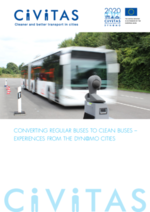Innovative Li-Ion hybrid trolleybuses on new line
Thematic areas
Clean & energy-efficient vehicles
Summary
Trolleybuses in Gdynia are extremely popular and are even nicknamed by the people. In order to increase the attractiveness of this silent and local zero emissions transport system even further, Gdynia planned to extend trolley lines into areas without wired infrastructure. The transport operator PKT purchased and tested battery hybrid trolleys, and deployed them in a residential area without public transport (PT) service. The exploitation served as an example for Polish cities in investing in a highly innovative transport system.
Implementing sustainable mobility
Trolleybuses are an important part of the City of Gdynia’s public transport (PT) system, and both the vehicles and the network have been systematically modernised. The City of Gdynia has also converted diesel buses into trolleybuses to obtain the most efficient fleet in Poland at lowest possible cost. The current trolleybus system services altogether 45 km. The trolleybus fleet consists of 85 vehicles of which 73 are currently operating.
In this measure, trolleybuses would be taken to new area, currently not operated by trolleybuses as there is no traction. The considered area is Skwer Kościuszki street: one of the most popular, crowded and touristy central streets in Gdynia. In the future, after testing under CIVITAS DYN@MO has been completed, the street would be served by the trolleybus without the need to build a traction system. The improved accessibility would improve the quality of life for Gdynia’s inhabitants and tourists.
Before CIVITAS DYN@MO, trolleybuses in the City of Gdynia were supplied with electrical energy provided from overhead wires. To increase the reliability many of them were equipped with NiCd batteries. While the current NiCd batteries were considered an efficient source of alternative drive in emergencies, they could not be deployed in unwired routes of regular scheduled trolleybuses due to technical limitations. Mainly, Ni-Cd batteries were very heavy, large and difficult to operate due to their memory effects. For this reason, it was better not to use more than the 70% of their capacity; otherwise their lifespan might drastically decrease. Also their charging time was quite long – 2 hours in case of totally uncharged batteries.
The innovative aspect of this measure has been to use a new traction battery technology (Li-Ion technology) for the extended trolleybus line. New types of batteries were be installed aboard the vehicles that would operate on the number 21 extended trolleybus line running in the heart of Gdynia.
Li-Ion batteries can be characterised by numerous advantages compared to commonly used battery types. For example, they are much lighter than other common batteries and hold a much greater energy capacity.
The main objectives of this measure were to:
- increase the reliability and flexibility of the trolleybus system
- expand the operation of electric public transport vehicles in new highly populated city areas
- purchase two innovative Li-Ion hybrid trolleybuses and deploy them on a 2 km new line
- reduce energy consumption by up to 3% as a result of reduction weight of vehicle
- increase space for passengers by seven people through reduced battery sizes
- increase awareness of other Polish cities about trolleybuses as the most energy and cost efficient, clean and “ready to use” mean of PT
Progress
Gdynia aims at becoming a leading Polish city with the most modern trolleybus system and fleet, and to encourage other Polish cities to implement trolleybuses. This measure would continue and further develop the results achieved in the European TROLLEY project. Numerous promotion and education campaigns have been planned to further the measure's aims, such as the annual European Trolleybus Day – a big event held every year in September.
Planning & preparation
- The analysis of available technologies of Li-Ion traction batteries has been completed. It consists of Working Document G2.1/WD0 and a publication titled Market overview of alternative battery technologies appropriate for the use in trolleybuses. The analysis was submitted in October 2013 and the design of battery equipment has been completed. This is documented in Working Document G2.1/WD1 about a concept outlining the use of lithium traction batteries for trolley vehicles. The document was completed in April 2014.
Implementation & demonstration
- The purchase of two trolleybuses with Li-Ion batteries (main components of electrical equipment are: traction motor, traction inverter, auxiliary converter, converter for traction batteries, traction batteries, control system and other devices) was carried out. Two new innovative Solaris trolleybuses arrived in Gdynia in February 2015. During a small ceremony took place and the local authorities released the vehicles for public use. The test phase began thereafter.
- Technical approval has been obtained
- Extension of the trolleybus line to Skwer Kościuszki Street in Gdynia
- Trolleybuses equipped with Li-Ion batteries will operate on the new extended line from June 2015
Outcomes
Tangible outputs:
- Extended trolleybus line to the section of the chosen street not previously served by the trolleybus
- Two trolleybuses with Li-Ion batteries provided for the extended line
- Increased capacity of vehicle by seven people
- Reduced energy consumption by 3% as a result of reduction of weight of vehicle
- Increased passenger space in a vehicle
Expected outcomes in the short- to medium-term:
- Enhanced public transport service in a highly populated and popular area
- Increased ridership on public transport and reduced individual traffic
- Lower local emissions due to electric traction
- Higher acceptance of trolleybus extensions in city areas where the construction of electric infrastructure is not possible (street with trees, historic buildings, resistance of residents, etc.)
Expected outcomes in the mid-term to long-term:
- Gdynia is a leading city regarding the most modern trolleybus fleet in Poland
- Gdynia is a model city for other Polish and at least Central-East European cities and the encouragement to introduce the trolleybus system where possible
- Increased shift in modal split to alternative modes of transport
- Improved integration between different modes of PT system in Gdynia (trolleybus and rapid urban railway)









